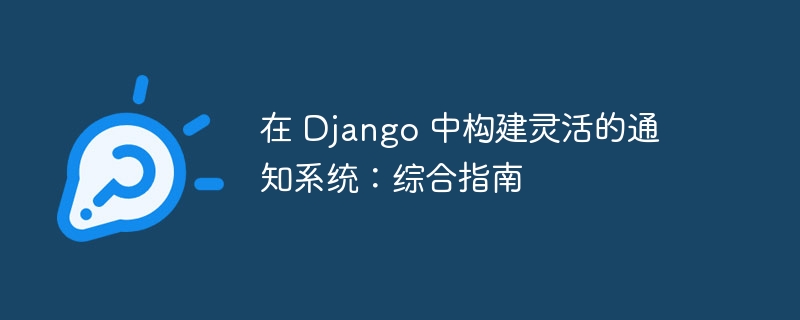在 Django 中构建灵活的通知系统:综合指南
来源:dev.to
时间:2024-12-29 09:10:02 231浏览 收藏
IT行业相对于一般传统行业,发展更新速度更快,一旦停止了学习,很快就会被行业所淘汰。所以我们需要踏踏实实的不断学习,精进自己的技术,尤其是初学者。今天golang学习网给大家整理了《在 Django 中构建灵活的通知系统:综合指南》,聊聊,我们一起来看看吧!

通知是任何现代 web 应用程序的关键组成部分,可确保用户了解情况并参与其中。实施良好的通知系统可以处理多个渠道,例如应用内警报、电子邮件和短信,同时动态定制内容以实现无缝的用户体验。在本指南中,我们将引导您在 django 中创建一个强大的、可扩展的通知系统。
系统功能
我们的通知系统旨在提供:
- 支持多渠道:通过应用内提醒、电子邮件或短信发送通知。
- 动态内容个性化:带有占位符的模板,用于生成个性化消息。
- 基于事件的触发器:根据特定系统或用户事件触发通知。
- 状态跟踪:监控电子邮件和短信通知的传送状态。
- 管理和系统集成:通知可以由管理员或系统事件触发。
定义模型
1.通知模板
模板是我们系统的支柱,存储可重复使用的通知内容。
from django.db import models
class channeltype(models.textchoices):
app = 'app', 'in-app notification'
sms = 'sms', 'sms'
email = 'email', 'email'
class triggeredbytype(models.textchoices):
system = 'system', 'system notification'
admin = 'admin', 'admin notification'
class triggerevent(models.textchoices):
enrollment = 'enrollment', 'enrollment'
announcement = 'announcement', 'announcement'
promotional = 'promotional', 'promotional'
reset_password = 'reset_password', 'reset password'
class notificationtemplate(models.model):
title = models.charfield(max_length=255)
template = models.textfield(help_text='use placeholders like {{username}} for personalization.')
channel = models.charfield(max_length=20, choices=channeltype.choices, default=channeltype.app)
triggered_by = models.charfield(max_length=20, choices=triggeredbytype.choices, default=triggeredbytype.system)
trigger_event = models.charfield(max_length=50, choices=triggerevent.choices, help_text='event that triggers this template.')
is_active = models.booleanfield(default=true)
created_at = models.datetimefield(auto_now_add=true)
updated_at = models.datetimefield(auto_now=true)
主要特点:
- 模板:带有动态值占位符的文本,例如 {{username}}.
- 渠道:指定是电子邮件、短信还是应用内通知。
- trigger_event:将模板与特定事件关联。
2.一般通知
通知模型将模板链接到用户并存储任何动态负载以进行个性化。
class notification(models.model):
user = models.foreignkey(user, on_delete=models.cascade, related_name="notifications")
content = models.foreignkey(notificationtemplate, on_delete=models.cascade, related_name="notifications")
payload = models.jsonfield(default=dict, help_text="data to replace template placeholders.")
is_read = models.booleanfield(default=false)
created_at = models.datetimefield(auto_now_add=true)
3.特定于渠道的模型
为了独特地处理电子邮件和短信,我们定义了特定的模型。
电子邮件通知
该模型管理特定于电子邮件的数据,例如动态消息生成和传递跟踪。
class statustype(models.textchoices):
pending = 'pending', 'pending'
success = 'success', 'success'
failed = 'failed', 'failed'
class emailnotification(models.model):
user = models.foreignkey(user, on_delete=models.cascade, related_name='email_notifications')
content = models.foreignkey(notificationtemplate, on_delete=models.cascade, related_name='email_notifications')
payload = models.jsonfield(default=dict)
status = models.charfield(max_length=20, choices=statustype.choices, default=statustype.pending)
status_reason = models.textfield(null=true)
@property
def email_content(self):
"""
populate the template with dynamic data from the payload.
"""
content = self.content.template
for key, value in self.payload.items():
content = re.sub(
rf"{{{{\s*{key}\s*}}}}",
str(value),
content,
)
return content
短信通知
与电子邮件通知类似,这里实现了短信特定逻辑。
class smsnotification(models.model):
user = models.foreignkey(user, on_delete=models.cascade, related_name='sms_notifications')
content = models.foreignkey(notificationtemplate, on_delete=models.cascade, related_name='sms_notifications')
payload = models.jsonfield(default=dict)
status = models.charfield(max_length=20, choices=statustype.choices, default=statustype.pending)
status_reason = models.textfield(null=true)
@property
def sms_content(self):
"""
populate the template with dynamic data from the payload.
"""
content = self.content.template
for key, value in self.payload.items():
content = re.sub(
rf"{{{{\s*{key}\s*}}}}",
str(value),
content,
)
return content
管理集成
为了更轻松地管理通知,我们在 django 管理面板中注册模型。
from django.contrib import admin
from notifier.models import notificationtemplate
@admin.register(notificationtemplate)
class notificationtemplateadmin(admin.modeladmin):
list_display = ['title', 'channel', 'triggered_by', 'trigger_event', 'is_active']
list_filter = ['channel', 'triggered_by', 'is_active']
search_fields = ['title', 'trigger_event']
通知服务
我们将实现一个服务层来管理通过各种渠道发送通知。
策略模式
使用策略模式,我们将为每个通知通道定义类。
from abc import abc, abstractmethod
import logging
logger = logging.getlogger(__name__)
class notificationstrategy(abc):
@abstractmethod
def send(self, user, content, payload):
pass
class appnotificationstrategy(notificationstrategy):
def send(self, user, content, payload):
notification = notification.objects.create(user=user, content=content, payload=payload)
logger.info(f"in-app notification sent to {user.email}")
return notification
class emailnotificationstrategy(notificationstrategy):
def send(self, user, content, payload):
notification = emailnotification.objects.create(user=user, content=content, payload=payload)
try:
self._send_email(user.email, content.title, notification.email_content)
notification.status = "success"
except exception as e:
notification.status = "failed"
notification.status_reason = str(e)
notification.save()
return notification
def _send_email(self, to_email, subject, body):
print(f"sending email to {to_email} with subject {subject}")
if "@" not in to_email:
raise valueerror("invalid email address")
class smsnotificationstrategy(notificationstrategy):
def send(self, user, content, payload):
notification = smsnotification.objects.create(user=user, content=content, payload=payload)
try:
self._send_sms(user.phone_number, notification.sms_content)
notification.status = "success"
except exception as e:
notification.status = "failed"
notification.status_reason = str(e)
notification.save()
return notification
def _send_sms(self, phone_number, message):
print(f"sending sms to {phone_number}: {message}")
if not phone_number.isdigit():
raise valueerror("invalid phone number")
通知服务
该服务将所有内容联系在一起,根据通知渠道选择适当的策略。
class notificationservice:
_strategies: dict[type[channeltype], type[notificationstrategy]] = {
channeltype.app: appnotificationstrategy,
channeltype.email: emailnotificationstrategy,
channeltype.sms: smsnotificationstrategy,
}
@classmethod
def get_strategy(cls, instance: notificationtemplate) -> notificationstrategy:
try:
channel = channeltype[instance.channel]
strategy = cls._strategies[channel]
except keyerror:
raise exception(f"unknown notification strategy {instance.channel}")
return strategy()
@classmethod
def notify(
cls,
user: user,
event: triggerevent,
payload: dict,
):
"""
automatically create and send a system-triggered notification.
args:
user: user instance.
event: triggerevent type.
payload: dynamic `dict` data for the notification.
returns:
result of the notification strategy.
"""
content, _ = notificationtemplate.objects.get_or_create(
trigger_event=event,
triggered_by=triggeredbytype.system,
defaults={
"title": 'default title',
"template": "this is a system notification.",
},
)
strategy = cls.get_strategy(instance=content)
return strategy.send(user, content, payload)
使用示例
以下是如何使用通知服务:
from notifier.services import NotificationService, TriggerEvent
user = User.objects.get(email="user@example.com")
payload = {"username": "John Doe", "course": "Python Basics"}
NotificationService.notify(user, TriggerEvent.USER_ENROLLED, payload)
如果您发现本指南很有帮助且富有洞察力,请不要忘记点赞并关注以获取更多此类内容。您的支持激励我分享更多实用的实现和深入的教程。让我们继续一起构建令人惊叹的应用程序!
终于介绍完啦!小伙伴们,这篇关于《在 Django 中构建灵活的通知系统:综合指南》的介绍应该让你收获多多了吧!欢迎大家收藏或分享给更多需要学习的朋友吧~golang学习网公众号也会发布文章相关知识,快来关注吧!
-
501 收藏
-
501 收藏
-
501 收藏
-
501 收藏
-
501 收藏
-
231 收藏
-
260 收藏
-
272 收藏
-
369 收藏
-
249 收藏
-
479 收藏
-
284 收藏
-
311 收藏
-
128 收藏
-
104 收藏
-
301 收藏
-
289 收藏
-

- 前端进阶之JavaScript设计模式
- 设计模式是开发人员在软件开发过程中面临一般问题时的解决方案,代表了最佳的实践。本课程的主打内容包括JS常见设计模式以及具体应用场景,打造一站式知识长龙服务,适合有JS基础的同学学习。
- 立即学习 543次学习
-

- GO语言核心编程课程
- 本课程采用真实案例,全面具体可落地,从理论到实践,一步一步将GO核心编程技术、编程思想、底层实现融会贯通,使学习者贴近时代脉搏,做IT互联网时代的弄潮儿。
- 立即学习 516次学习
-

- 简单聊聊mysql8与网络通信
- 如有问题加微信:Le-studyg;在课程中,我们将首先介绍MySQL8的新特性,包括性能优化、安全增强、新数据类型等,帮助学生快速熟悉MySQL8的最新功能。接着,我们将深入解析MySQL的网络通信机制,包括协议、连接管理、数据传输等,让
- 立即学习 500次学习
-

- JavaScript正则表达式基础与实战
- 在任何一门编程语言中,正则表达式,都是一项重要的知识,它提供了高效的字符串匹配与捕获机制,可以极大的简化程序设计。
- 立即学习 487次学习
-

- 从零制作响应式网站—Grid布局
- 本系列教程将展示从零制作一个假想的网络科技公司官网,分为导航,轮播,关于我们,成功案例,服务流程,团队介绍,数据部分,公司动态,底部信息等内容区块。网站整体采用CSSGrid布局,支持响应式,有流畅过渡和展现动画。
- 立即学习 485次学习
